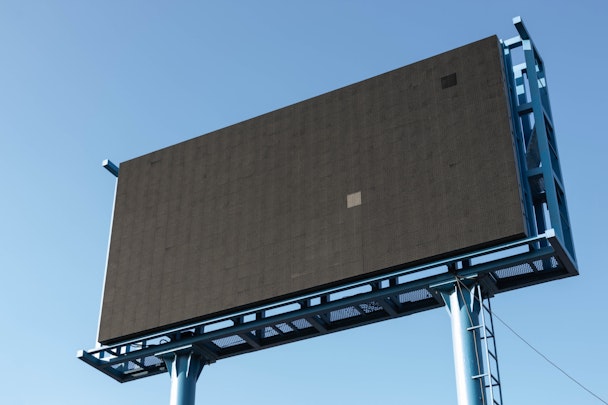The rise digital OOH won't end with the evolution of the billboard
For The Drum’s out-of-home Deep Dive, Rowan Byers of The Goat Agency looks at the headline-grabbing 3D billboards of 2022, and how mobile integration will keep the revolution moving.

What's coming next in out-of-home? Watch out for digital developments and mobile integrations / Pawel Czerwinski via Unsplash
During the Covid-19 pandemic, as the world became reliant on social media ads, a rebirth of digital out-of-home (OOH) advertising could not have been better-timed.
Ads across TikTok, Instagram, YouTube and wider social media apps have adapted to new technologies and creative offerings, enabling social advertisers to appeal to intended audiences better than ever before.
In a triumphant post-pandemic revival, the integration of immersive technologies like augmented and virtual reality have transcended existing understandings of OOH. Leading the way this year was Sony. Ahead of the highly anticipated blockbuster Morbius, Sony took to the streets of Milan to shock passersby with perhaps their scariest marketing effort to date. Using augmented reality technology, the ad encapsulated the film’s vampiric themes with a massive 3D billboard, showing a character ripping and snarling its way through the frame.
This followed in the success of a Venom: Let There Be Carnage placement that adopted the same AR technologies to convey themes of horror, amplifying shock value to raise hype around the film’s launch.
Advertisement
The billboard is evolving
Increased adoption of augmented reality across OOH advertising is clear, with more recent usage coming from Call of Duty and Meta who took to London’s Piccadilly Circus to showcase their latest products through the art of immersive, visual storytelling.
Creative uses of 3D imagery are being used to sell everything from movies to video games to virtual reality peripherals. In particular, the last couple of years have seen a surge in anamorphic billboards. From product to IP and beyond, the format is being used to cultivate our imaginations and subvert expectations.
Immersive 3D billboards are not only experienced through the eyes of IRL audiences, but through screens via user-generated content. This opens eye-opening opportunities beyond whatever 60-second narrative is being told on the side of a building, allowing context to be added.
Snapchat’s partnership with the Black Cultural Archives back in February highlighted just how immersive OOH can be, and how the format can spark interest from younger demographics by integrating social media. Ahead of Black History Month, Snap’s educational campaign centered around the representation of black history across London. Launched by Nelson Mandela’s granddaughter, it used AR technology to expose often-overlooked history and stories, encouraging passersby to use Snap to view AR statues, stories and artwork across London.
The use of augmented reality, combined with social media, enabled black creators and influential figures to receive proper representation. Snap’s campaign expanded the boundaries and capabilities of AR, bringing an immersive and educational experience to a younger demographic. It’s permanently available through Snapchat to extend black history education year-round.
Advertisement
Customizing the user experience through mobile integration
In the post-pandemic market, OOH advertising is about enhancing the user experience. To increase engagement opportunities, brands must consider the possibilities of integrating mobile. As we’ve seen with Snap’s Black History Month AR rollout, this tech helps potential customers interact with OOH ads and share real-time data with the brand. These IRL engagements provide brands with authentic feedback, opening the door to a more customized user experience.
In 2023, outdoor advertising will become coherent with social media, mobile and even television, forming a multi-channel approach. The implementation of all three mediums will be instrumental in ensuring that messages are consistent with the brand’s image. 2023 strategies should focus on symmetry: aligning the cause across TV, social and OOH.
Suggested newsletters for you
Digital OOH (DOOH) is more effective
3D and AR underline the future of outdoor advertising. DOOH has the power to deliver greater results than old school OOH.
With digital screens enabling a more dynamic approach to ad creative, brands can channel video, animation, 3D and AR, making ads more enticing to passersby.
Digital ads are also more measurable than traditional counterparts. In a data-driven world, that’s never a bad thing. With the advent of programmatic digital out of home (pDOOH), brands can run targeted and highly customized campaigns using real-time analytics. This format uses automated buying platforms to bid on ad placements in real time, enabling bidding similar to that in other forms of digital media, incorporating budget spend, impressions and ‘effective cost-per-mile’.
Content by The Drum Network member:

The Goat Agency
We’re the leading global social media marketing agency powered by influencers. We pride ourselves in bringing together data-led performance, real human relationships,...
Find out more
